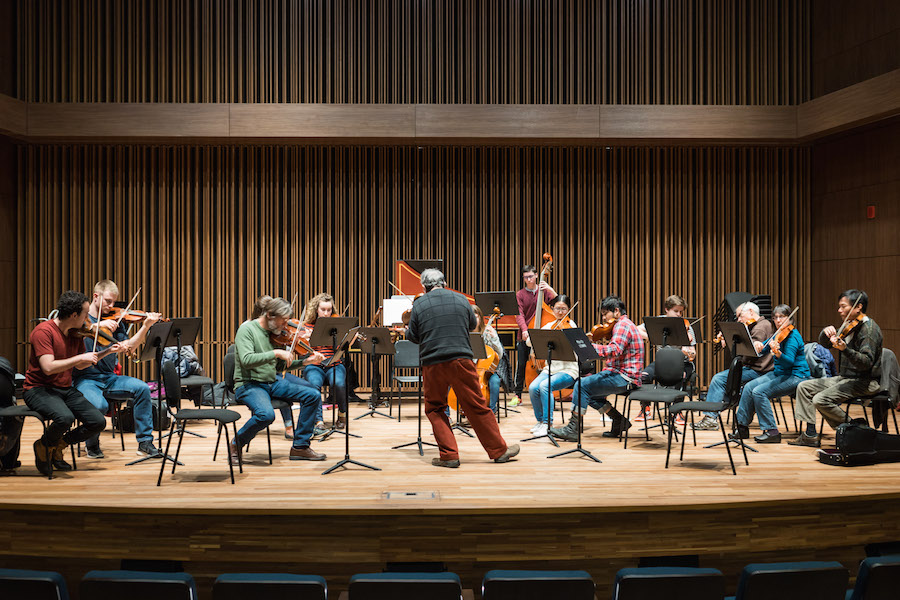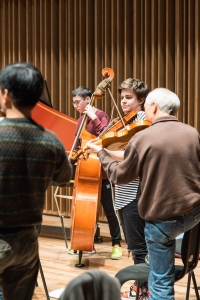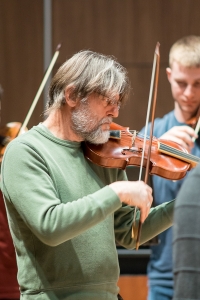
Students in baroque ensemble play instruments quintessential to seventeenth, eighteenth century
At first glance, the UC Davis Baroque Ensemble might look like a smaller version of a symphony orchestra. The Baroque Ensemble recreates music dating back to the seventeenth and eighteenth centuries using string instruments like the cello, viola and violin.
To play in this ensemble, one needs prior experience with string instruments. But unlike modern string instruments, baroque instruments lack certain modifications that are commonly used today, meaning that the musician will need to learn how to adjust to play using old techniques.
Phebe Craig, the co-director of the ensemble, said that one of the biggest challenges students may face upon joining the ensemble is learning how to adapt to these instruments and alter the way that they are used to playing.

“People usually need to have a number of years of experience just so they can get around on the instrument, but once they’re a part of our group, we hand them an instrument that isn’t exactly like the ones they’re used to,” Craig said. “We hand them baroque instruments with different strings and the bows are very different. They harken back to the instruments that were being used in the seventeenth and eighteenth century, making everything a little more authentic when we’re discovering how people played back then.”
The materials of baroque instruments also create entirely different sounds from their modern counterparts, particularly the strings and the bow.
“Violins nowadays have these fine tuners on them so you can get close to the right pitch with your pegs,” Craig said. “Baroque instruments don’t have that. These strings are made of very organic material and the humidity or heat might change it a little bit and it can go out of tune, so students have to figure out how to keep the instruments tuned.”
Michael Sands, another co-director of the Baroque Ensemble, agreed that playing an instrument much different from ones a musician is used to can be difficult, but not impossible.
“The players really have to put themselves out,” Sands said. “To get the sound right, a lot of people have to adjust the way they’re used to playing.”
According to Craig, this group is much different from the symphony orchestra since it is much more personal and participation-based.
“Usually Baroque orchestras are a little smaller,” Craig said. “A lot of the music-making is kind of creating conversations. Baroque music is more comfortable and you can have a little more of yourself in the music. Since we’re smaller and don’t make that loud of a sound, it’s the participation that’s so nice.”

Sands also emphasized the importance of playing as a group and being part of the ensemble as co-director of the Baroque Ensemble.
“We have a very relaxed atmosphere,” Sands said. “Phebe plays the harpsichord and I play the violin. We’re playing with the students, not staying back directing, which makes us very different.”
The UC Davis Baroque Ensemble also serves as a great way for music majors to receive their required hours of performance. Victor Karadi, a third-year music major, has been a part of this ensemble for two quarters and believes it helps him expand his perception on music.
“It’s a really different vibe than being in a forty or sixty-person ensemble,” Karadi said. “You’re also a lot closer to the people around you. The music also feels fresh because you’re getting this other perspective on something you’ve done before.”
For more information about the Baroque Ensemble and for upcoming performance dates, please visit http://arts.ucdavis.edu/baroque-ensemble.
Written by: Becky Lee — arts@theaggie.org



